So it seems my lifelong nickname is/was a Piedmontese word for noise, crash/clatter/bang or scream/shout/squawk:
![[french/piedmnotese dictionary text]
Scruss s.; Bruit, fracas, cri.
La porta a la fait un scruss;
La porte a crié, a fait un cri.](https://scruss.com/wordpress/wp-content/uploads/2020/02/piedmontese-scruss.png)
An early 19th century dictionary written by an Italian count had my number all along.
So it seems my lifelong nickname is/was a Piedmontese word for noise, crash/clatter/bang or scream/shout/squawk:
![[french/piedmnotese dictionary text]
Scruss s.; Bruit, fracas, cri.
La porta a la fait un scruss;
La porte a crié, a fait un cri.](https://scruss.com/wordpress/wp-content/uploads/2020/02/piedmontese-scruss.png)
An early 19th century dictionary written by an Italian count had my number all along.
Hey! This is really old! FreeCAD 0.19 is in the Raspberry Pi OS Bullseye repo now:
sudo apt install freecad
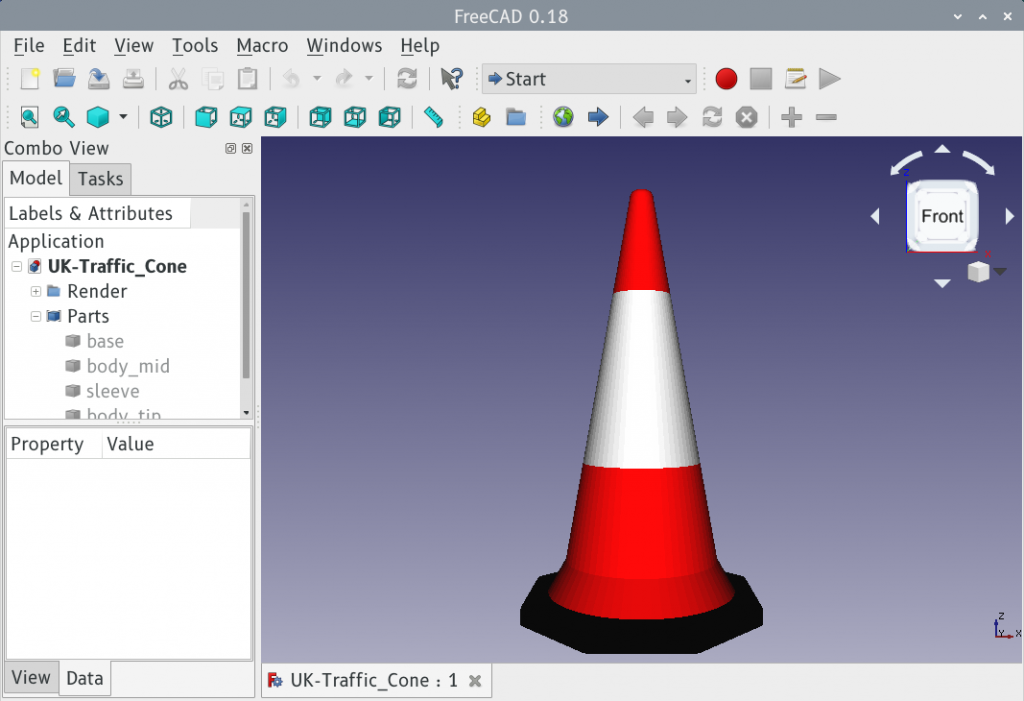
FreeCAD and the Raspberry Pi haven’t always got on too well. For complex technical reasons the standard package would load and immediately crash on a Raspbian system. For user reasons, this was just another annoyance.
Recent releases seem to run fairly well on a Raspberry Pi 4, though, but only after building them from source. Here’s a method that got FreeCAD 0.18.4 running for me. It’s lightly modified from FreeCAD forum MartijnD‘s post:
sudo apt install cmake build-essential libtool lsb-release swig libboost-dev libboost-date-time-dev libboost-filesystem-dev libboost-graph-dev libboost-iostreams-dev libboost-program-options-dev libboost-python-dev libboost-regex-dev libboost-serialization-dev libboost-signals-dev libboost-thread-dev libcoin-dev libeigen3-dev libgts-bin libgts-dev libkdtree++-dev libmedc-dev libopencv-dev libproj-dev libvtk6-dev libx11-dev libxerces-c-dev libzipios++-dev qt4-dev-tools libqt4-dev libqt4-opengl-dev libqtwebkit-dev libshiboken-dev libpyside-dev pyside-tools python-dev python-matplotlib python-pivy python-ply python-pyside libocct*-dev occt-draw libsimage-dev doxygen libcoin-doc dh-exec libspnav-dev
wget https://github.com/FreeCAD/FreeCAD/archive/0.18.4.zip
unzip 0.18.4.zip
rm 0.18.4.zip
mkdir freecad-build
cd freecad-build
cmake -DPYTHON_EXECUTABLE=/usr/bin/python2.7 -DPYTHON_INCLUDE_DIR=/usr/include/python2.7 -DPYTHON_LIBRARY=/usr/lib/arm-linux-gnueabihf/libpython2.7.so -DPYTHON_PACKAGES_PATH=/usr/local/lib/python2.7/dist-packages/ ../FreeCAD-0.18.4/
make -j4Notes:
If you want to learn how to use it, look at the tutorials: even the Raspberry Pi Foundation have written some. The UK Traffic Cone model you can have: it’s what I made to learn a bit more about FreeCAD. Don’t worry, I’m still on Team OpenSCAD …
CBC says that Alberta’s looming multibillion-dollar orphan wells problem prompts auditor general probe. I mean, I’d say it does: estimated costs to clean up abandoned petrochemical wells outstrip the industry cleanup fund by over 132×, so it’s gone way past looming and is well into omnishambles country. But I’m not here to talk about the environmental mismanagement (well, not much: lolRedwater …), but more to talk about CBC’s terrible infographic:

The image is accurate, technically. The estimated liabilities ($30100000000) are 132.6× the total security held ($227000000), and the red square’s length is 11½× (= √132.6) the blue one’s. But people are generally terrible at comparing areas.
Here are the same numbers, but in bar chart form:

And there’s the problem: it’s too big to comprehend. CBC’s comfortable little chart fits on a page; you can tweet it, even. But reality is a whole lot of scrolling down the page.
Even the manky old pie chart would be better than CBC’s squares-by area:

At least pie charts used linear measure as a proportion of the full 360° pie. But comparing areas is hard; in the diagram below, the teal-coloured part is twice the area of the gold part.
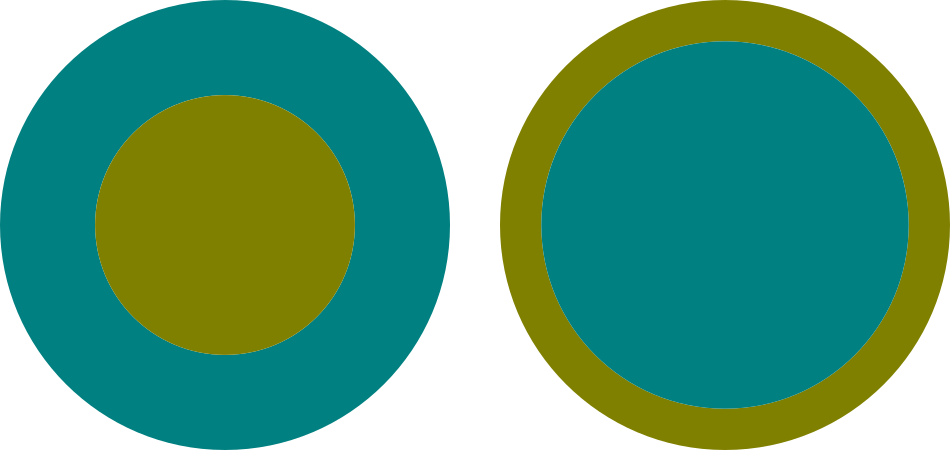

Update, a few panicked minutes later: false alarm. Still no news release from OPG or province-wide phone alert to stand down, but there is this:
Important update: the alert regarding #Pickering Nuclear was sent in error. There is no danger to the public or environment.
— Ontario Power Gen (@opg) January 12, 2020
Just as a reminder, you can get potassium iodide pills for free if you live within 50 km of an Ontario nuclear installation. Go to preparetobesafe.ca

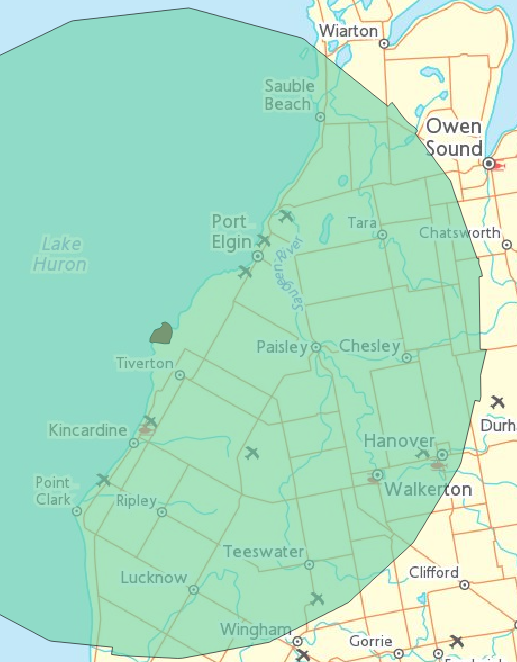
I don’t know if I should be including Chalk River in this.
Further update: yup, they retracted it. But a scary wee-waa-wee-waa siren while the text is read in a robot voice is not very reassuring
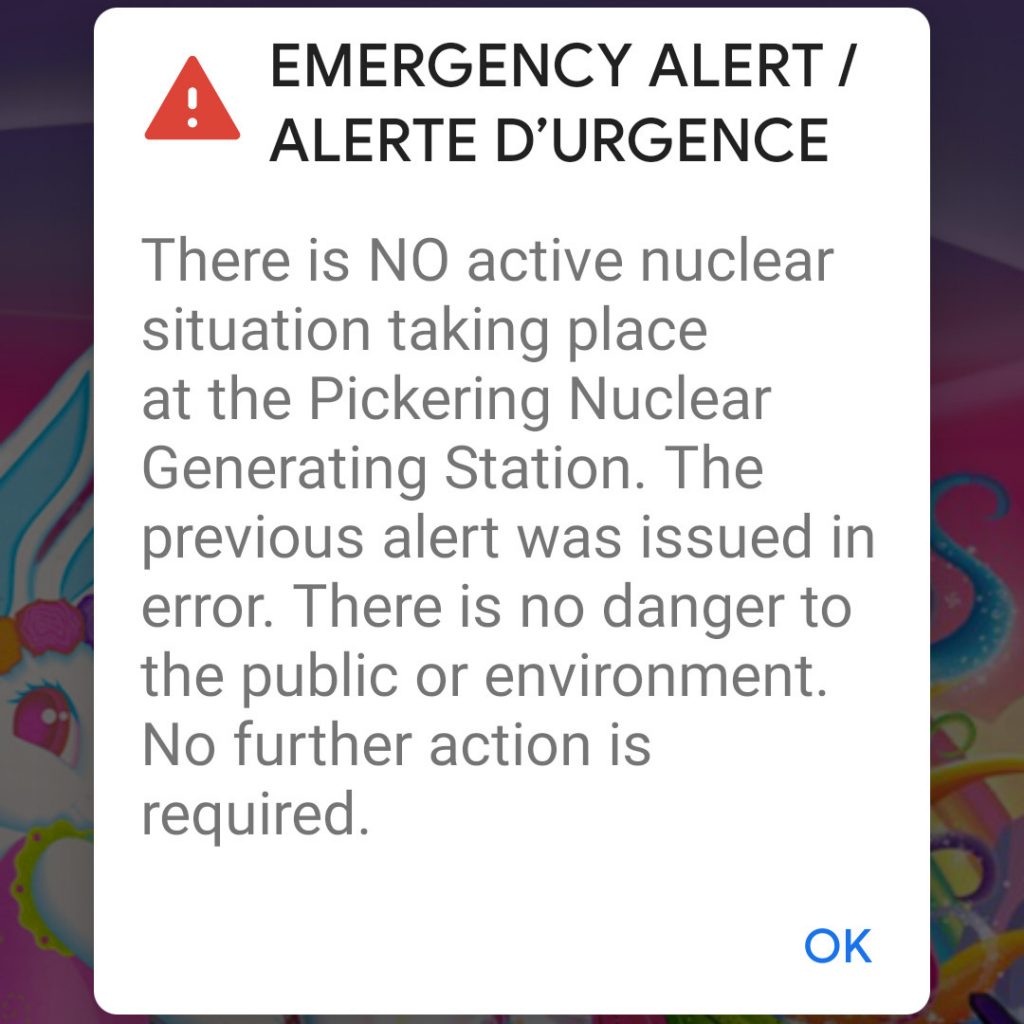
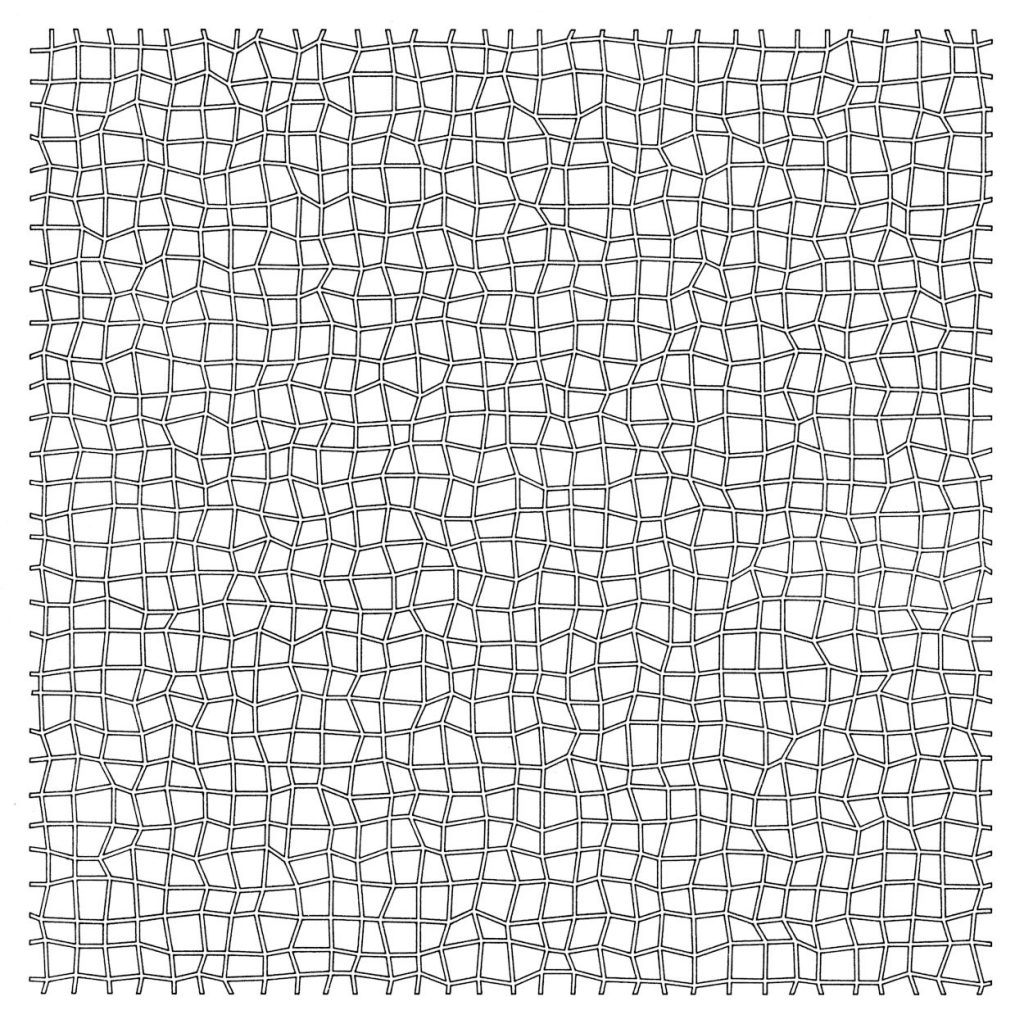
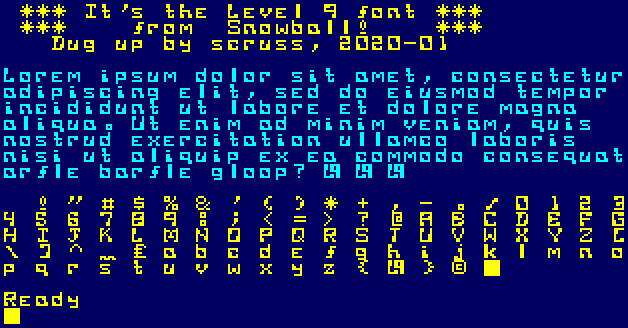
Oooh blecch — did I really like this when I was a young ‘un? Following on from the same process as in The coolest font (when I was 15, that is) here’s the bitmap font from Level 9’s Snowball.
10 REM *** L9SFONT.BAS *** 15 REM bitmap font from Level 9's 20 REM Snowball text adventure 30 REM on the Amstrad CPC 464 40 REM (it was so cool at the time ...) 50 REM Dug up by scruss, 2020-01 60 REM ============================== 100 SYMBOL AFTER 32 110 MODE 1 120 GOSUB 1000 130 PRINT" *** It's the Level 9 font ***" 140 PRINT" *** from Snowball! ***" 150 PRINT" Dug up by scruss, 2020-01" 160 PRINT 170 PEN 2 180 PRINT"Lorem ipsum dolor sit amet, consectetur" 190 PRINT"adipiscing elit, sed do eiusmod tempor" 200 PRINT"incididunt ut labore et dolore magna" 210 PRINT"aliqua. Ut enim ad minim veniam, quis" 220 PRINT"nostrud exercitation ullamco laboris" 230 PRINT"nisi ut aliquip ex ea commodo consequat" 240 PRINT"arfle barfle gloop? | | |" 250 PRINT 260 PEN 1 270 FOR i%=32 TO 127 280 PRINT CHR$(i%); " "; 290 NEXT i% 300 PRINT 310 PRINT 990 END 1000 SYMBOL 33,&10,&28,&28,&28,&10,0,&38,0 1010 SYMBOL 34,&66,&66,&44,&88,0,0,0,0 1020 SYMBOL 35,0,&24,&7e,&24,&24,&7e,&24,0 1030 SYMBOL 36,&10,&7c,&40,&7c,&04,&7c,&10,0 1040 SYMBOL 37,&e4,&a4,&e8,&10,&2e,&4a,&4e,0 1050 SYMBOL 38,&70,&88,&88,&72,&84,&88,&76,0 1060 SYMBOL 39,&0c,&0c,&08,&10,0,0,0,0 1070 SYMBOL 40,&0c,&10,&30,&30,&20,&14,&0c,0 1080 SYMBOL 41,&30,&28,&04,&0c,&0c,&08,&30,0 1090 SYMBOL 42,&10,&54,&38,&fe,&38,&54,&10,0 1100 SYMBOL 43,0,&10,&10,&7c,&10,&10,0,0 1110 SYMBOL 44,0,0,0,0,&18,&18,&10,&20 1120 SYMBOL 45,0,0,0,&fc,0,0,0,0 1130 SYMBOL 46,0,0,0,0,&1c,&14,&1c,0 1140 SYMBOL 47,0,&06,&0e,&08,&10,&70,&60,0 1150 SYMBOL 48,&fc,&8c,&8c,&84,&c4,&c4,&fc,0 1160 SYMBOL 49,&30,&10,&10,&10,&18,&18,&38,0 1170 SYMBOL 50,&f8,&98,&08,&f8,&80,&c8,&f8,0 1180 SYMBOL 51,&7c,&64,&04,&3c,&34,&04,&7c,0 1190 SYMBOL 52,&c8,&88,&88,&f8,&08,&18,&18,0 1200 SYMBOL 53,&f8,&98,&80,&f0,&08,&c8,&f0,0 1210 SYMBOL 54,&78,&98,&80,&f8,&98,&c8,&f8,0 1220 SYMBOL 55,&fc,&c4,&04,&08,&08,&18,&18,0 1230 SYMBOL 56,&fc,&c4,&8c,&fc,&84,&9c,&fc,0 1240 SYMBOL 57,&fc,&e4,&84,&fc,&04,&0c,&0c,0 1250 SYMBOL 58,&38,&28,&38,0,&38,&28,&38,0 1260 SYMBOL 59,&18,&18,0,&18,&18,&10,&20,0 1270 SYMBOL 60,&04,&08,&10,&20,&10,&08,&04,0 1280 SYMBOL 61,0,0,&7e,0,&7e,0,0,0 1290 SYMBOL 62,&80,&40,&20,&10,&20,&40,&80,0 1300 SYMBOL 63,&7c,&04,&1c,&10,&10,0,&10,0 1310 SYMBOL 64,&3e,&22,&2e,&2a,&2e,&20,&3e,0 1320 SYMBOL 65,&fc,&c4,&8c,&fc,&84,&c4,&c4,0 1330 SYMBOL 66,&f8,&84,&e4,&f8,&84,&9c,&f8,0 1340 SYMBOL 67,&fc,&8c,&80,&80,&c0,&c4,&fc,0 1350 SYMBOL 68,&f8,&64,&64,&44,&4c,&4c,&f8,0 1360 SYMBOL 69,&fc,&8c,&c0,&f8,&c0,&8c,&fc,0 1370 SYMBOL 70,&fc,&9c,&80,&f8,&80,&c0,&c0,0 1380 SYMBOL 71,&fc,&9c,&80,&9c,&c4,&c4,&fc,0 1390 SYMBOL 72,&c4,&c4,&84,&fc,&84,&8c,&8c,0 1400 SYMBOL 73,&7c,&14,&10,&10,&10,&50,&7c,0 1410 SYMBOL 74,&7c,&54,&10,&18,&18,&90,&60,0 1420 SYMBOL 75,&c8,&90,&a0,&d0,&88,&8c,&8c,0 1430 SYMBOL 76,&c0,&c0,&c0,&80,&80,&98,&f8,0 1440 SYMBOL 77,&82,&ee,&92,&92,&ba,&82,&c6,0 1450 SYMBOL 78,&8c,&c4,&c4,&b4,&8c,&8c,&84,0 1460 SYMBOL 79,&fc,&c4,&c4,&84,&8c,&8c,&fc,0 1470 SYMBOL 80,&fc,&c4,&8c,&fc,&80,&c0,&c0,0 1480 SYMBOL 81,&fc,&c4,&c4,&84,&94,&88,&f4,0 1490 SYMBOL 82,&fc,&c4,&8c,&fc,&90,&c8,&cc,0 1500 SYMBOL 83,&fc,&84,&80,&78,&04,&84,&fc,0 1510 SYMBOL 84,&7c,&10,&10,&10,&30,&30,&30,0 1520 SYMBOL 85,&c4,&c4,&84,&8c,&8c,&8c,&fc,0 1530 SYMBOL 86,&c4,&84,&84,&48,&48,&30,&30,0 1540 SYMBOL 87,&84,&84,&84,&b4,&b4,&cc,&84,0 1550 SYMBOL 88,&cc,&cc,&48,&30,&48,&cc,&cc,0 1560 SYMBOL 89,&86,&86,&44,&28,&10,&18,&18,0 1570 SYMBOL 90,&fc,&84,&08,&30,&40,&84,&fc,0 1580 SYMBOL 91,&7c,&60,&60,&40,&40,&4c,&7c,0 1590 SYMBOL 92,0,&60,&30,&10,&08,&0c,&06,0 1600 SYMBOL 93,&3e,&32,&02,&02,&06,&06,&3e,0 1610 SYMBOL 94,&18,&24,&42,&42,0,0,0,0 1620 SYMBOL 95,0,0,0,0,0,0,&ee,&bb 1630 SYMBOL 96,&3c,&22,&78,&20,&78,&20,&7e,0 1640 SYMBOL 97,0,0,&f8,&98,&88,&cc,&fc,0 1650 SYMBOL 98,&80,&80,&f8,&98,&88,&c8,&f8,0 1660 SYMBOL 99,0,0,&f8,&88,&c0,&c8,&f8,0 1670 SYMBOL 100,&08,&08,&f8,&98,&88,&c8,&f8,0 1680 SYMBOL 101,0,0,&f8,&80,&e0,&80,&f8,0 1690 SYMBOL 102,0,&1c,&10,&38,&38,&10,&70,0 1700 SYMBOL 103,0,0,&f8,&98,&88,&f8,&08,&78 1710 SYMBOL 104,&c0,&c0,&80,&f8,&88,&cc,&cc,0 1720 SYMBOL 105,0,&60,0,&60,&60,&70,&70,0 1730 SYMBOL 106,&08,0,&18,&18,&08,&08,&68,&78 1740 SYMBOL 107,&c0,&c0,&cc,&d8,&f0,&d8,&cc,0 1750 SYMBOL 108,&30,&30,&30,&30,&30,&30,&30,0 1760 SYMBOL 109,0,0,&cc,&b4,&b4,&84,&84,0 1770 SYMBOL 110,0,0,&f8,&98,&88,&cc,&cc,0 1780 SYMBOL 111,0,0,&f8,&98,&88,&c8,&f8,0 1790 SYMBOL 112,0,0,&f8,&98,&88,&f8,&80,&80 1800 SYMBOL 113,0,0,&f8,&88,&c8,&f8,&0c,&0c 1810 SYMBOL 114,0,0,&f8,&98,&80,&c0,&c0,0 1820 SYMBOL 115,0,0,&f8,&80,&70,&08,&f8,0 1830 SYMBOL 116,&60,&60,&20,&78,&20,&28,&38,0 1840 SYMBOL 117,0,0,&c8,&c8,&98,&98,&f8,0 1850 SYMBOL 118,0,0,&cc,&cc,&88,&70,&20,0 1860 SYMBOL 119,0,0,&84,&84,&b4,&b4,&cc,0 1870 SYMBOL 120,0,0,&cc,&48,&30,&48,&cc,0 1880 SYMBOL 121,0,0,&88,&c8,&f8,&08,&08,&78 1890 SYMBOL 122,0,0,&f8,&90,&20,&48,&f8,0 1900 SYMBOL 123,&0c,&30,&10,&60,&10,&30,&0c,0 1910 SYMBOL 124,&df,&db,&db,&9f,&83,&9b,&fb,0 1920 SYMBOL 125,&30,&0c,&08,&06,&08,&0c,&30,0 1930 SYMBOL 126,&7c,&82,&ba,&a2,&ba,&82,&7c,0 1940 SYMBOL 127,&FF,&FF,&FF,&FF,&FF,&FF,&FF,&FF 1950 RETURN
Process was the same:
sc=32; pnminvert snowball_font.pbm | pnmnoraw | tail +3 | cut --character="1-8"|while read f; do echo "printf '&%02x, \n' "\"\$((2#${f}))\"; done | bash | fmt -w43 | sed 's/,$//;' | while read g; do echo SYMBOL $sc", "$g; sc=$((sc + 1)); done | awk '{print 10 * (NR + 0) " " $0;}' > schars032to063.bas
TBH, the 901447-10m third-party font for the PET did the Data 70/Westminster faux-MICR thing better, and likely earlier too.
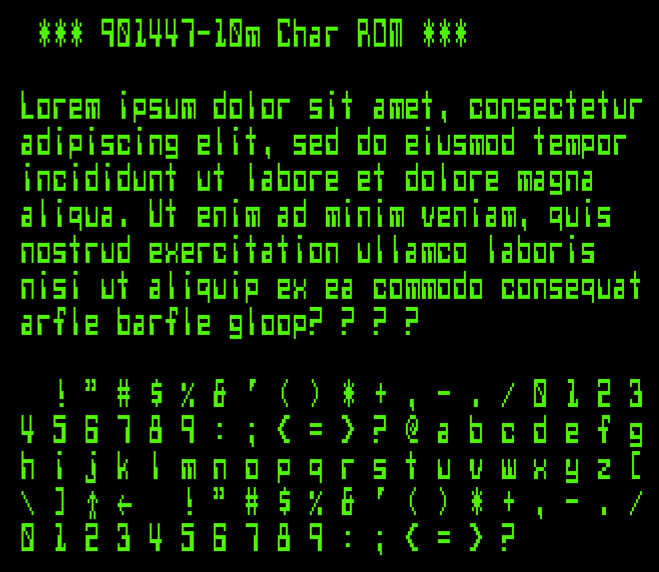
(I’m still writing this. It will change over time.)
“Use an STM32 Blue Pill or Black Pill micro-controller boardâ€, they said. “So cheap, so powerfulâ€, they said. “You’ll love itâ€, they said.
Dear Reader, none of the above turned out to be true.
For some time now I’ve been looking for a cheap, USB HID micro-controller board that is somewhat more flexible than the ATMega32U4 (Arduinos Leonardo, Micro and Pro Micro; also the impossibly smol Atto) and yet not quite as flexible as the let’s-accidentally-overwrite-our-accessibility-code-with-the-holiday-snaps CircuitPython boards from Adafruit. And for a while it looked like the STM32 boards might do it: they’ve got a 72 MHz ARM Cortex-M3 with at least 64 KB of Flash and 20 KB of SRAM and they’re under $5. Yay?
Not quite. There are three main problems with the STM32 boards that get in the way of inexpensive electronic nerdery.
Slightly grotty photos follow. One day I’ll get a better USB microscope.
First, the chip from a “Black Pill†board bought recently:

Compare with a “Blue Pill†bought last year:
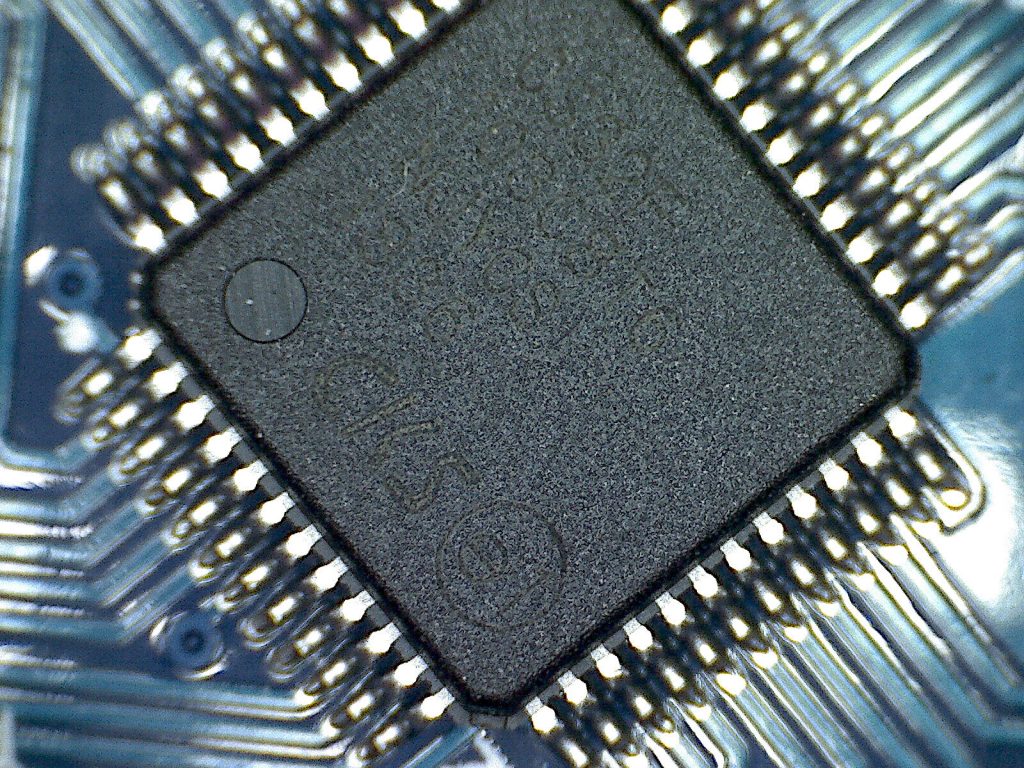
Knock-offs are rife in the cheap end of the market, and at least this chip is honest enough to say that it’s not from STMicroelectronics. While it may be possible to program these things with some heroic faffing about, consider balancing the effort required versus the time cost of doing so.
moar later (about the Blue Pill’s incorrect resistor)
even moar later (about a very dedicated amateur’s hosting of the project documentation becoming too successful for him to afford)
(Huge thanks to Andrew Klaassen who provided me his notes for getting some of these boards at least able to run Blink under Linux.)
Georg Nees (1926–2016) was a pioneer of generative art. His piece “Schotter” (gravel) from 1968 displayed a rectangular array of squares with the position of each square becoming more random as the piece progressed.
The BASIC code for this video is based on Processing code by Jim Plaxco, http://www.artsnova.com/
The Tektronix 4010 display simulator is by Rene Richarz, https://github.com/rricharz/Tek4010
The BASIC interpreter with Tektronix graphics support is Matrix Brandy BASIC maintained by Michael McConnell, https://github.com/stardot/MatrixBrandy
(Higher-quality video at Georg Nees’ “Schotter”, reproduced on a simulated Tek4010 display at YouTube.)
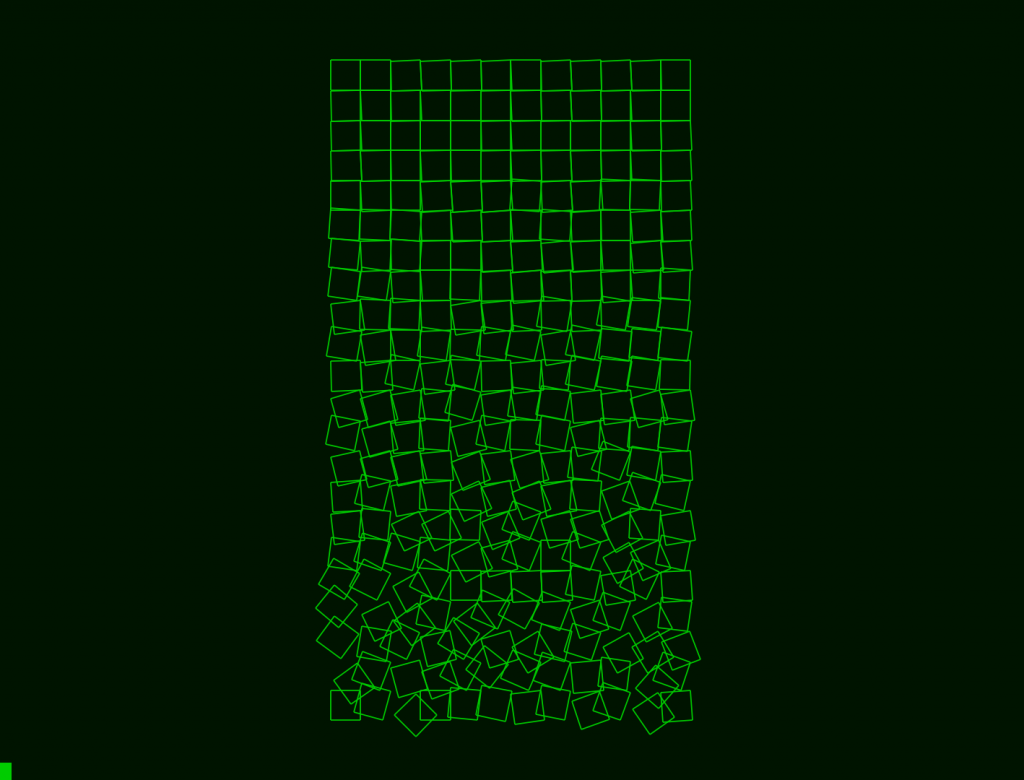
100 REM Georg Nees "Schotter" reproduction - scruss, 2019-11
110 REM based on Processing 3 code by Jim Plaxco, www.artsnova.com
120 :
130 scrn_wd% = 2048: REM fixed screen size, unlike Processing
140 scrn_ht% = 1560
150 columns% = 12
160 rows% = 22
170 sqsize% = FN_min(scrn_wd% / (columns% + 4), scrn_ht% / (rows% + 4))
180 padding% = 2 * sqsize%
190 randstep = 0.22
200 randsum = 0.0
210 randval = 0.0
220 dampen = 0.45
230 :
240 SYS "Brandy_TekEnabled", 1
250 A$=GET$: REM PLOT 4, 0, 0: PLOT 5, 0, 0
260 FOR y% = 1 TO rows%
270 randsum = randsum + (y% * randstep)
280 FOR x% = 1 TO columns%
290 randval = RND(1) * (2 * randsum) - randsum
300 PROC_square((scrn_wd% / 2) - (sqsize% * columns% / 2) + (x% * sqsize%) - (sqsize% / 2) + INT(randval * dampen), scrn_ht% - (padding% + (y% * sqsize%) - (sqsize% / 2) + INT(randval * dampen)), sqsize%, randval)
310 NEXT x%
320 NEXT y%
330 PLOT 4, 0, 0: PLOT 5, 0, 0
340 END
350 :
360 DEF PROC_square(cx%, cy%, side, angle)
370 LOCAL r, i%, pm%
380 pm% = 4: REM plot mode - move = 4, draw = 5
390 r = (side / 2) / (SQR(2) / 2)
400 FOR i% = 0 TO 4
410 PLOT pm%, cx% + r * COS(RAD(angle + i% * 90 + 45)), cy% + r * SIN(RAD(angle + i% * 90 + 45))
420 pm% = 5
430 NEXT i%
440 ENDPROC
450 :
460 DEF FN_min(a%, b%) IF a% < b% THEN =a% ELSE =b%
Update: I get a mention here: Schotter – Georg Nees – Part 2!
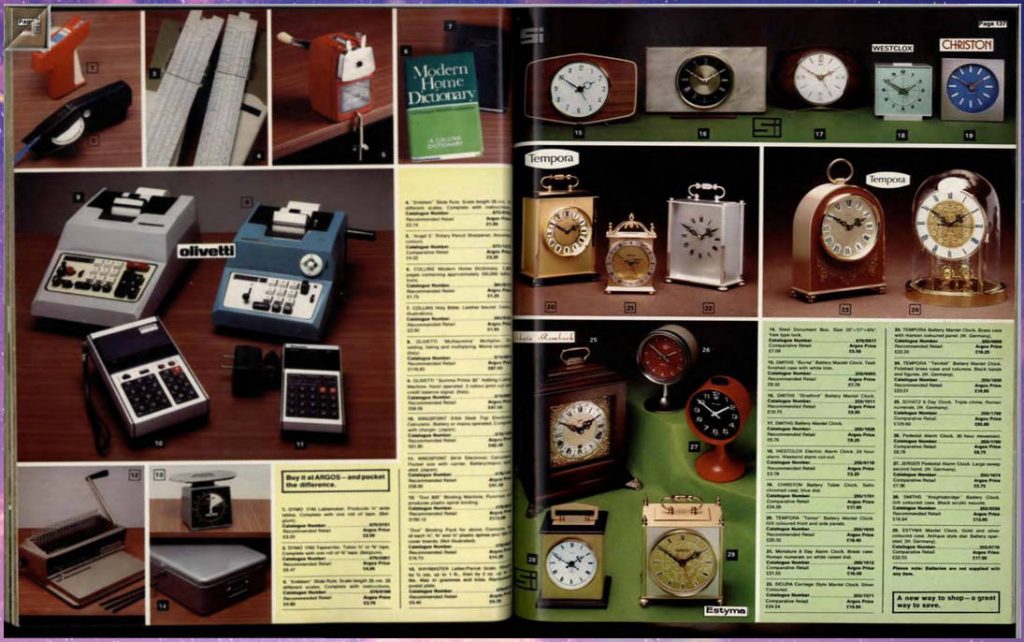
A little slice of UK consumer history: The Argos Book of Dreams, scanned Argos catalogues from 1974 to present. (Via b3ta)
It seems that all (?) of these are also up at the Internet Archive. They’re a little harder to find, and some don’t have previews. A decent search for one uploader’s history is “retromashâ€, though “argos catalogue†finds more. The Book of Dreams site seems only to have autumn/winter catalogues, while the Archive has the spring/summer ones too.
Back in 1973, the future definitely wasn’t equally distributed. While in Scotland we had power cuts, the looming three-day week and Miners’ Strike I, in California, the People’s Computer Company (PCC) was giving distributed computer access, teaching programming and publishing computer magazines. I don’t think we got that kind of access until (coincidentally) Miners’ Strike II a little over 10 years later.
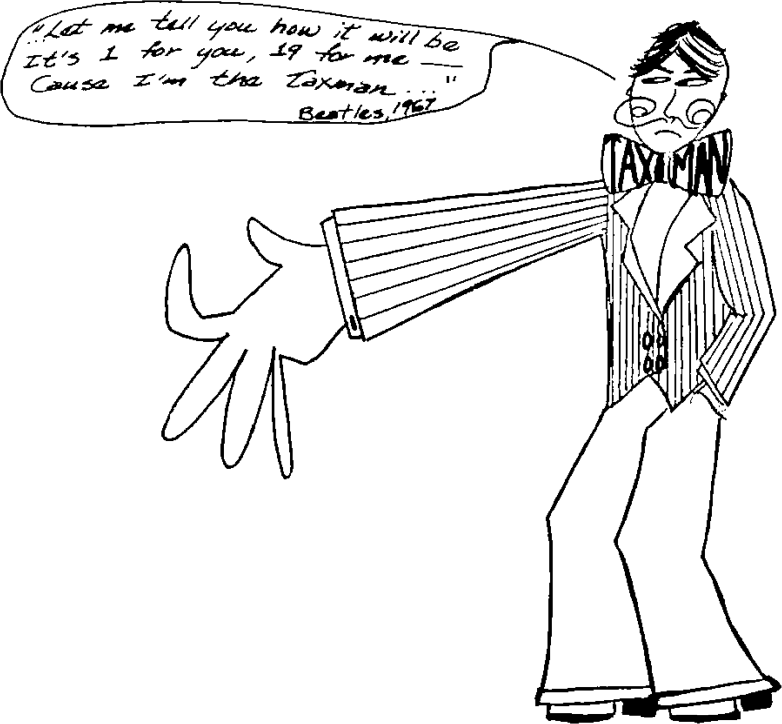
But the People’s Computer Company magazine archive is a sunny thing, overfilled with joyful amateur enthusiasm and thousands of lines of code fit to make Edsger Dijkstra explode. Of course it was written for the local few who had access to mainframes and terminals, but it hardly seems to come from the same world as the dark evenings in Scotland spent cursing the smug neighbours’ house with all the lights on, their diesel generator putt-putting into the night.
Lots of these games from the PCC era are forgettable now. The raw challenge of guessing a number on a text screen has paled somewhat in the face of 4K photo-realistic rendering. One game I found is still a little challenging, at least until you work out the trick of it: Taxman (or as the authors tried to rename it later, Factor Monster). Here’s a tiny sample game transcript:
Hi, I'm the taxman Do you want the regulations? (1=Yes, 0=No)? 0 How many numbers do you want in the list? 6 The list is: 1 2 3 4 5 6 You take? 5 Your total is 5 I get 1 My total is 1 New list: 2 3 4 6 You take? 6 Your total is 11 I get 2 3 My total is 6 New list: 4 I get 4 because no factors of any number are left. My total is 10 You 11 Taxman 10 You win !!! Again (1=yes, 0=no)?
Seems I sneaked a lucky win there, but it’s harder than it looks. The rules are simple:
For such a simple game (or perhaps, such a simple me) the computer wins surprisingly often. Since I find it fun to play, I thought I’d share the 1973 love as much as possible by porting to all of the BASIC dialects that I knew.
Plain text BASIC – taxman.bas – runs under interpreters such as bas. Almost verbatim from the 1973 publication. May not allow you to play again on some interpreters; you might want to try my slightly rearranged 40 column version that should run on systems that don’t allow a variable to be dimensioned twice.
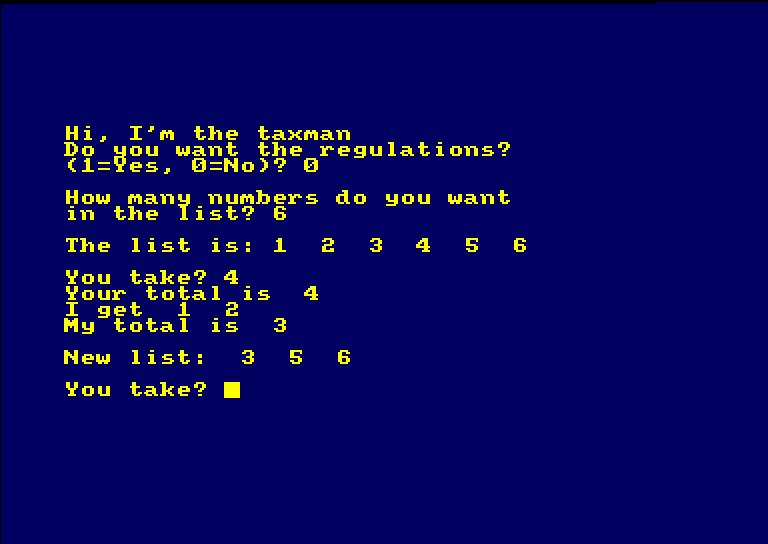
Amstrad CPC Locomotive BASIC – taxman.dsk – or as I call it, BASIC. 40 columns yellow on blue is how BASIC should look.
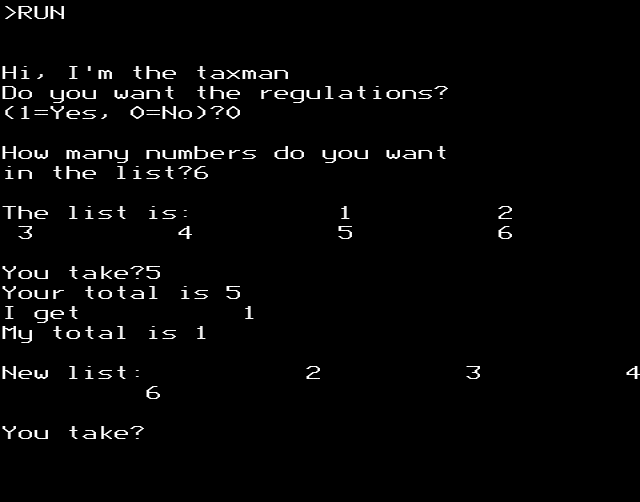
BBC BASIC – taxman.ssd – for all the boopBeep fans out there. You can actually play this one in your browser, too. Yes, the number formatting is weird, but BBC BASIC was always its own master.
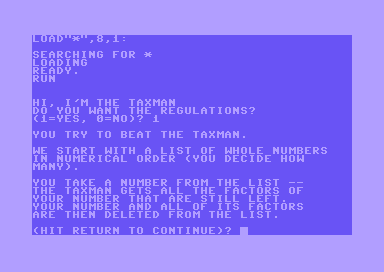
Commodore 64 – taxman.prg – very very upper case for this dinosaur of a BASIC.

Apple II AppleSoft BASIC – TAXMAN.DSK – lots of fiddling with import tools and dialect weirdness because Apple.

ZX Spectrum (Sinclair BASIC) – taxman.tap – 32 columns plus a very special dialect (no END, GOTO and GOSUB are GO TO and GO SUB) meant this took a while, but it was quite rewarding to get going.
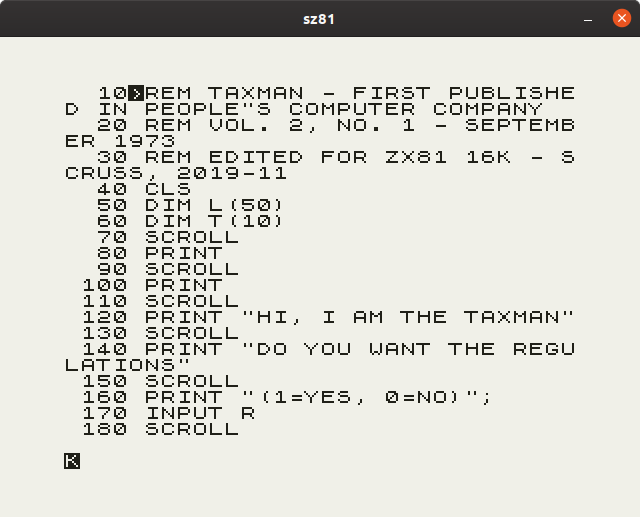
Sinclair ZX81 (16 K) – taxman.p – this one was a fight. The ZX81 didn’t scroll automatically, so you have to invoke SCROLL before every newline-generating PRINT or else your program will stop. For some reason this version gets unbearably slow near the end of long games, but it does complete.

After reading I didn’t know lithophanes were so simple. They were hiding in Cura all along. : 3Dprinting, I thought I’d give OpenSCAD a shot at generating a lithophane image. It did not badly at all, considering this was my first try.
This isn’t a fast process and generates huge STL files, but it’s fairly simple. Here’s how I did it:
// somewhat rough OpenSCAD lithophane - scruss, 2019-10 infile = "479px-Muhammad_Ali_NYWTS.png"; // input image, PNG greyscale best x_px = 479; // input image width, pixels y_px = 599; // input image height, pixels z_min = 0.8; // minimum output thickness, mm z_max = 3; // maximum output thickness, mm y_size = 50; // output image height, mm // don't need to modify anything below here translate([0, 0, z_max])scale([y_size / y_px, y_size / y_px, (z_max - z_min)/100])surface(file = infile, invert = true); cube([x_px * y_size / y_px, y_size, z_min]);
I used Makerbot warm white PLA. It looks decent at viewing distance, but close up it’s a bit stringy.

There are better packages, but OpenSCAD does this better than I expected.
BBC BASIC bot [beta2] on Twitter is lovely. You tweet a BBC BASIC program to it and it replies with an animation rendering of what your program would look like on a BBC Micro.
I sent it this:
1MODE4:VDU23,224,24,48,96,193,131,6,12,24:VDU23,225,24,12,6,131,193,96,48,24 2PRINTCHR$(224.5+RND(1));:GOTO2
which readers might recognize as 10 PRINT, the endless random maze one-liner for the C64. This program even inspired its own book – also called 10 PRINT CHR$(205.5+RND(1)); : GOTO 10 – about simple generative art.
You can run it in your browser thanks to the amazing JSBeeb.
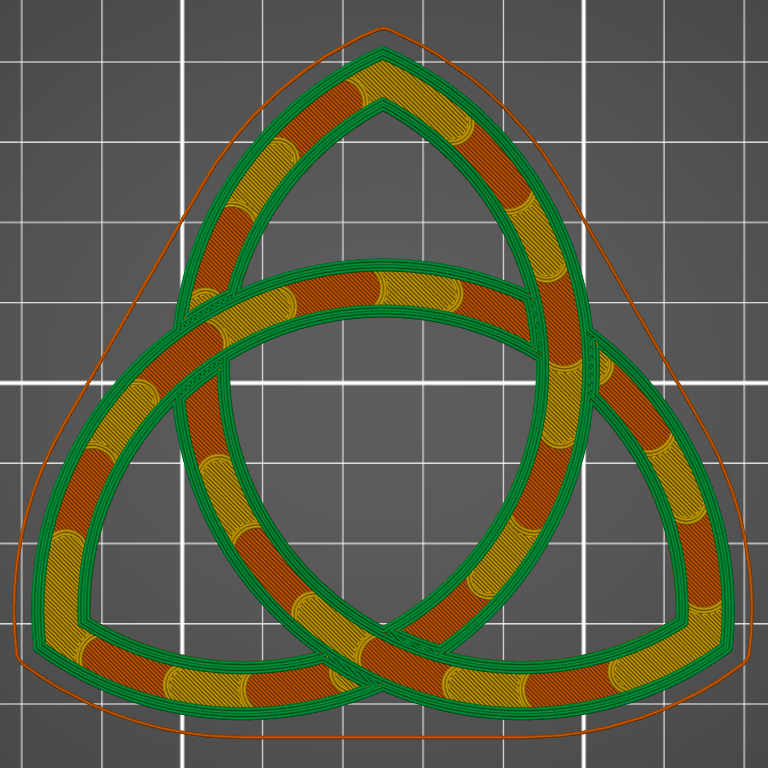
I killed some time this lunchtime in a thrift store. I was half-looking for a case for a kit computer, but wasn’t expecting much to turn up. But I found this:
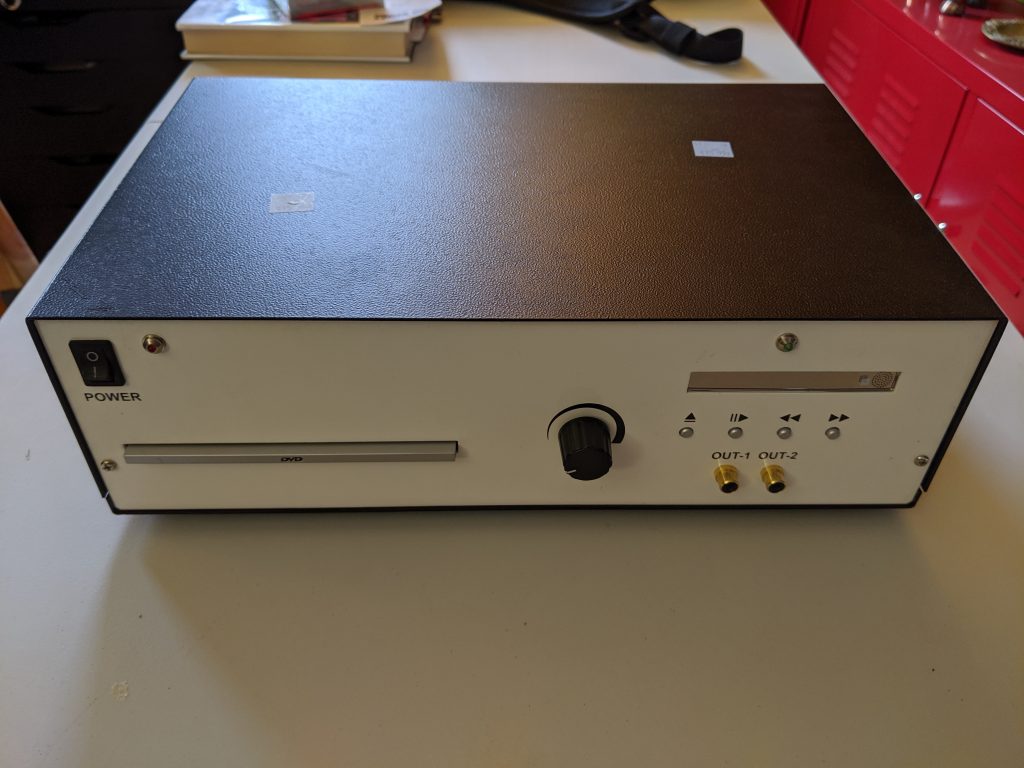
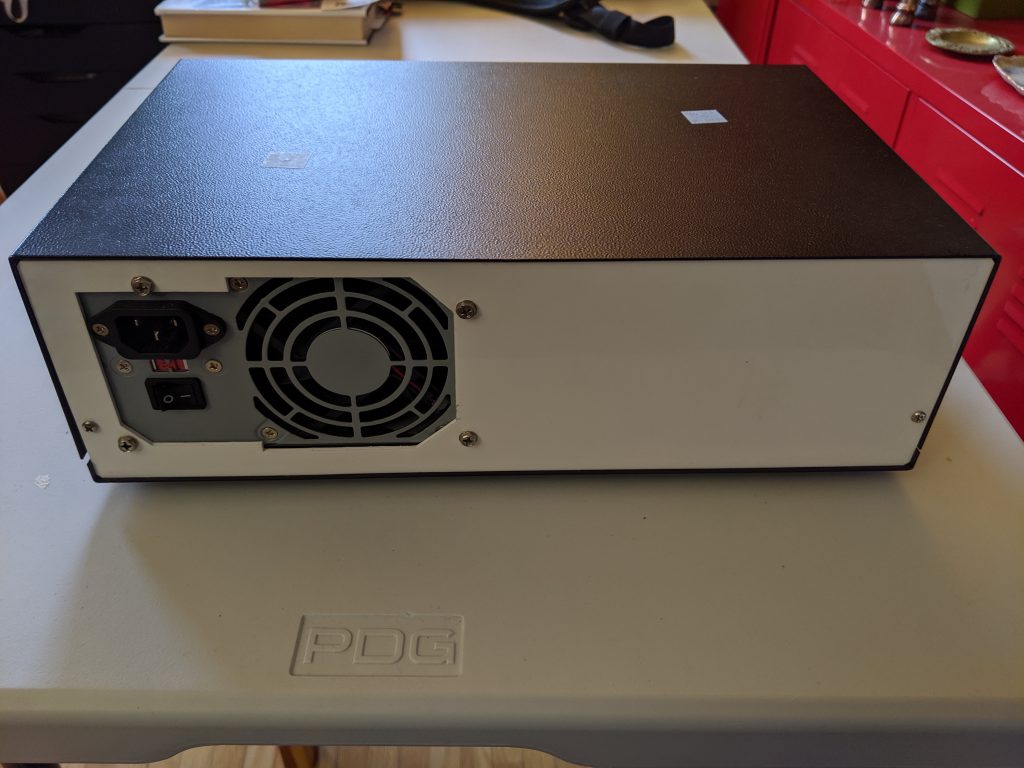
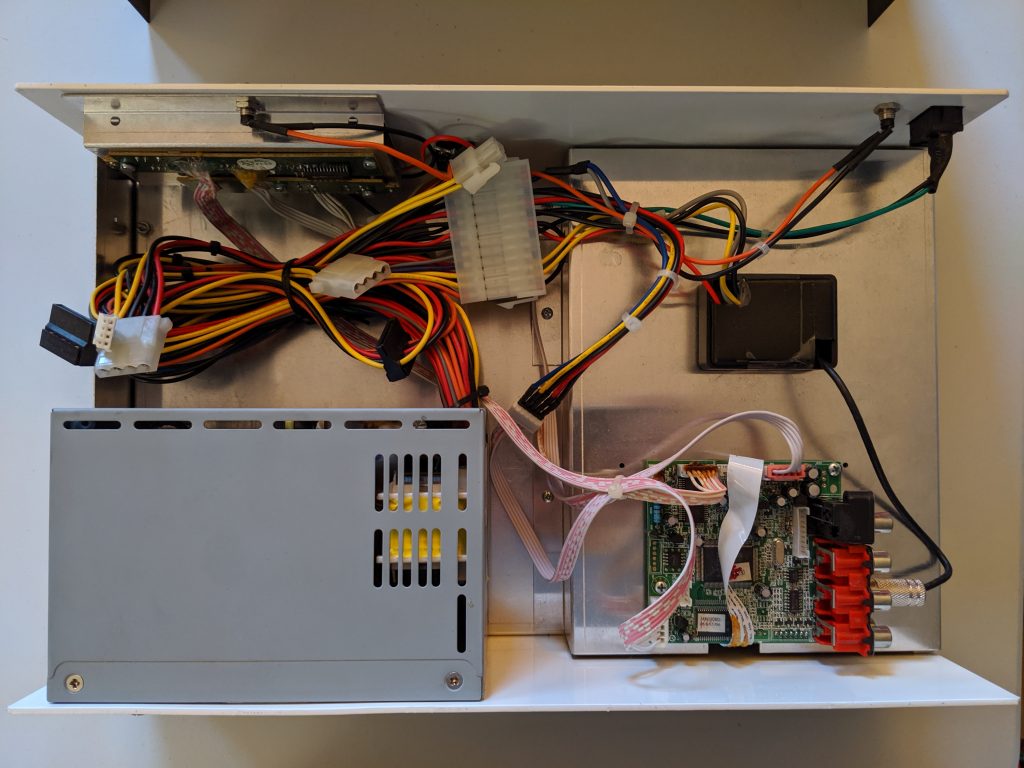
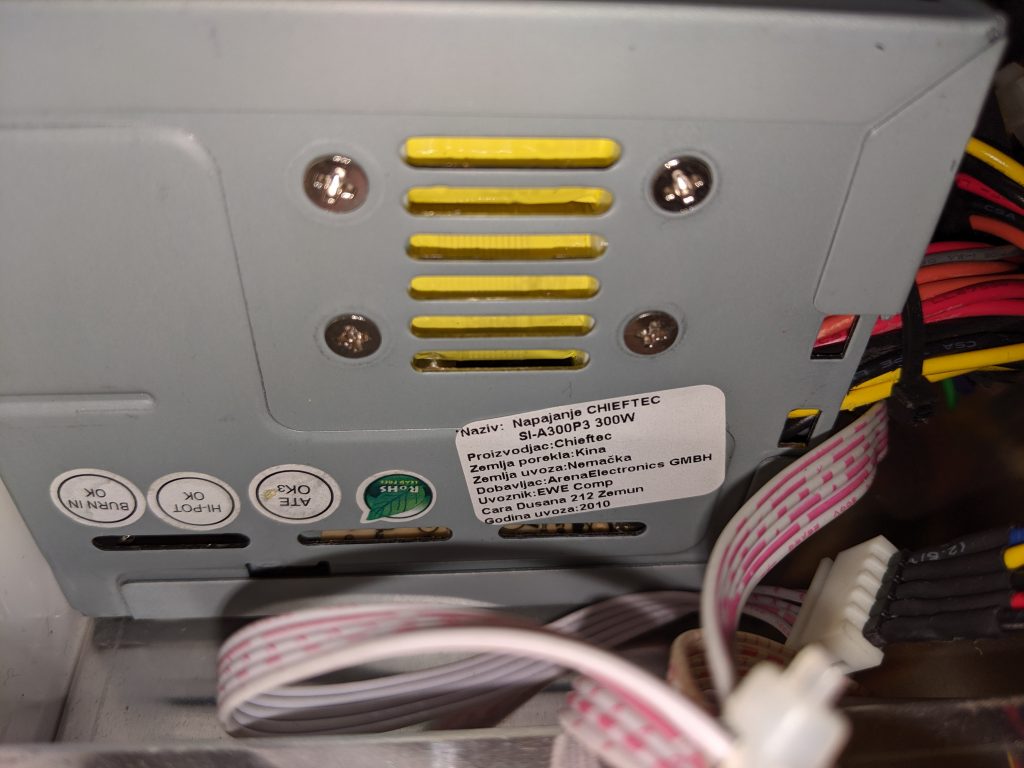
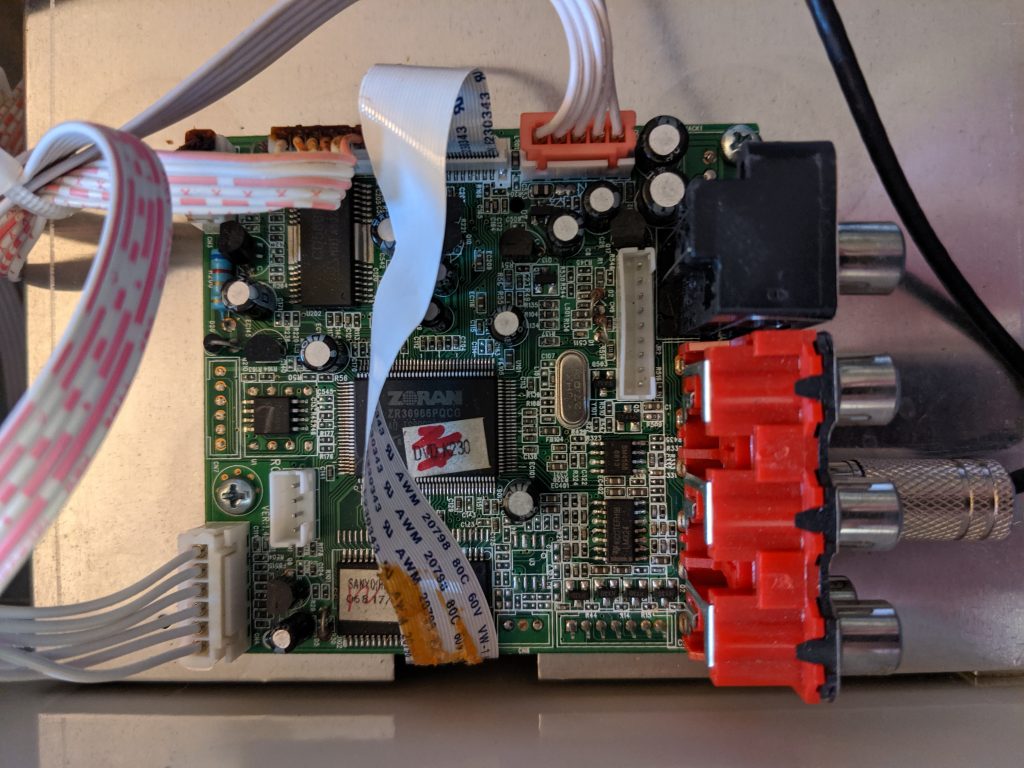
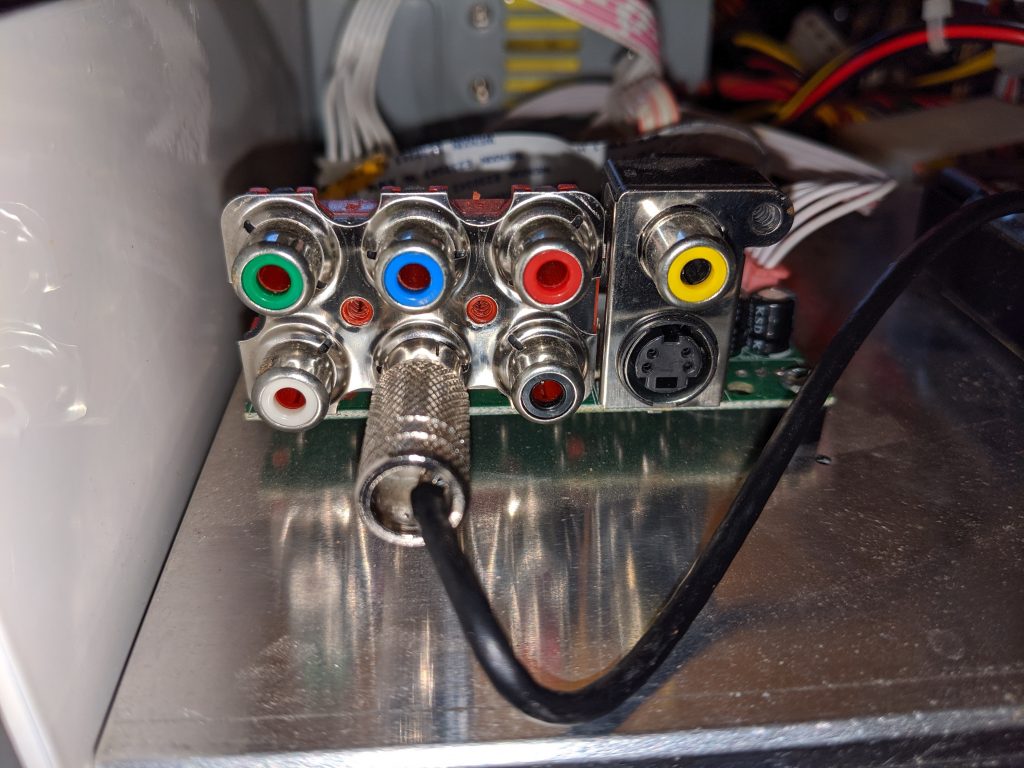
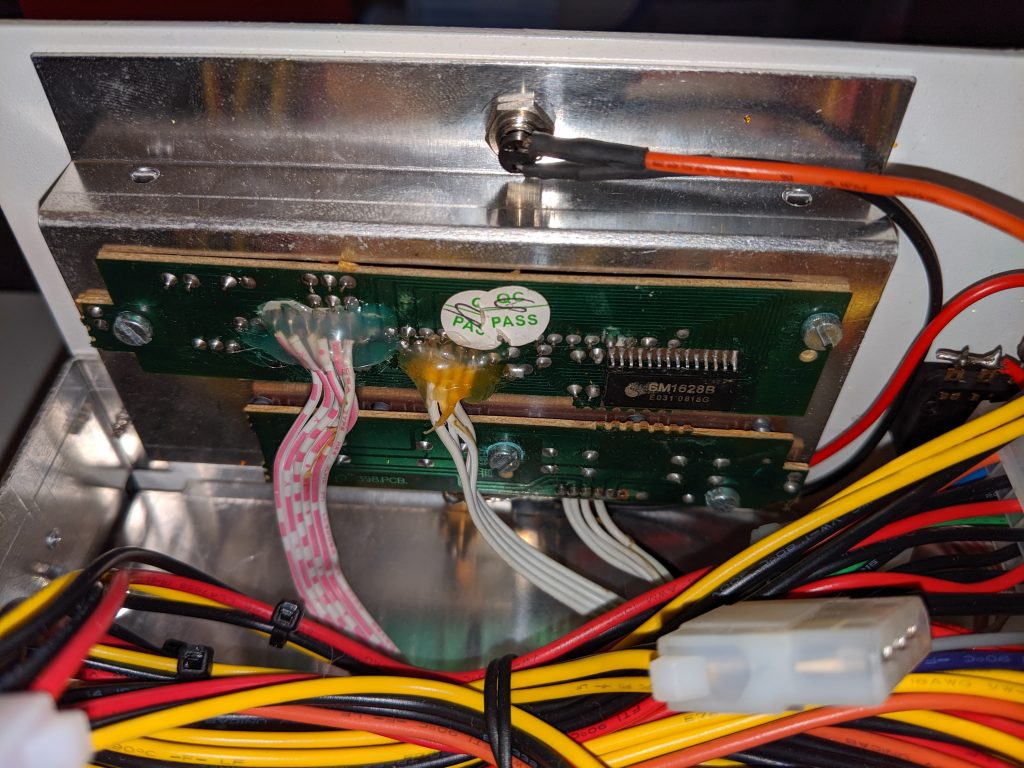
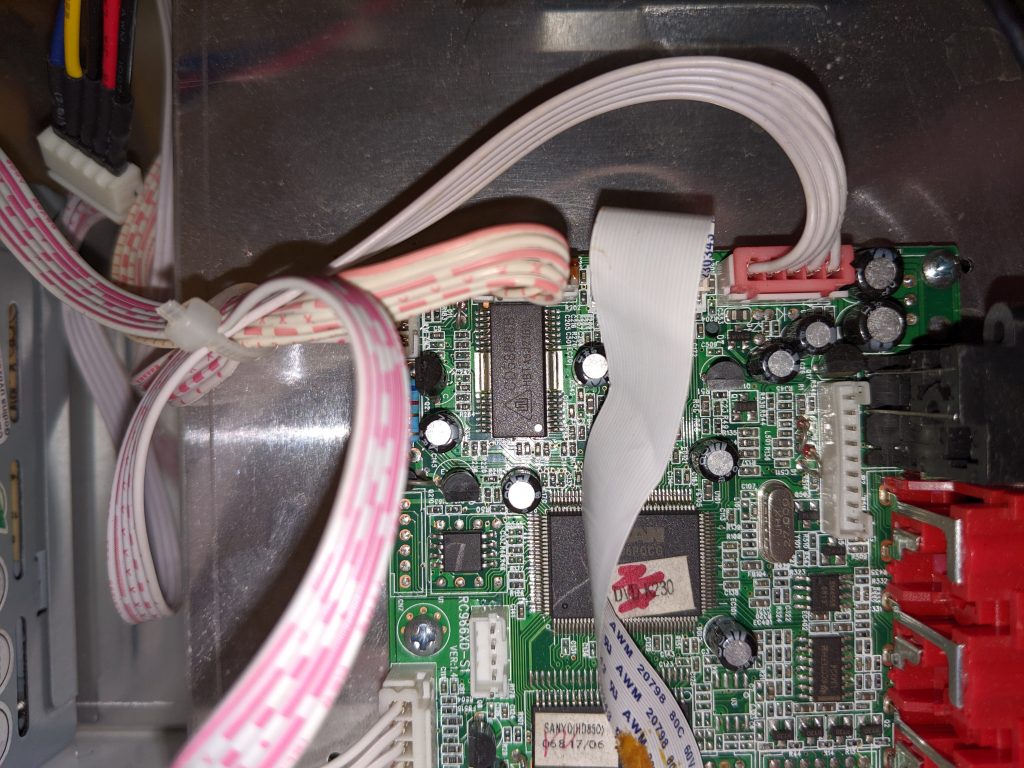
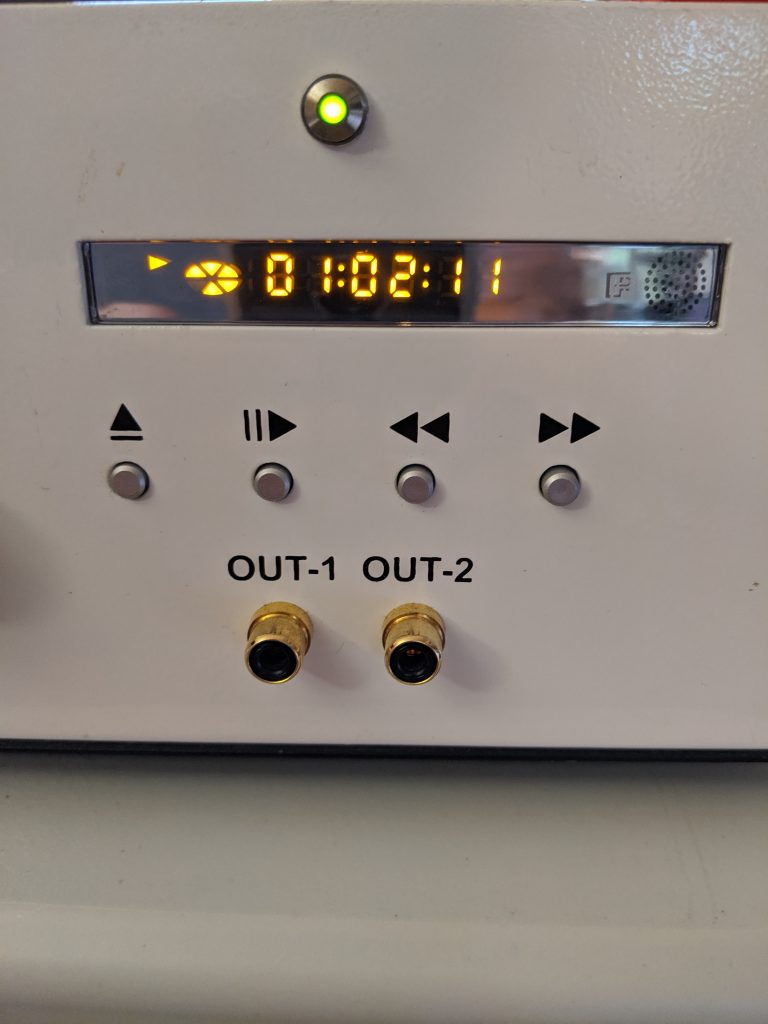
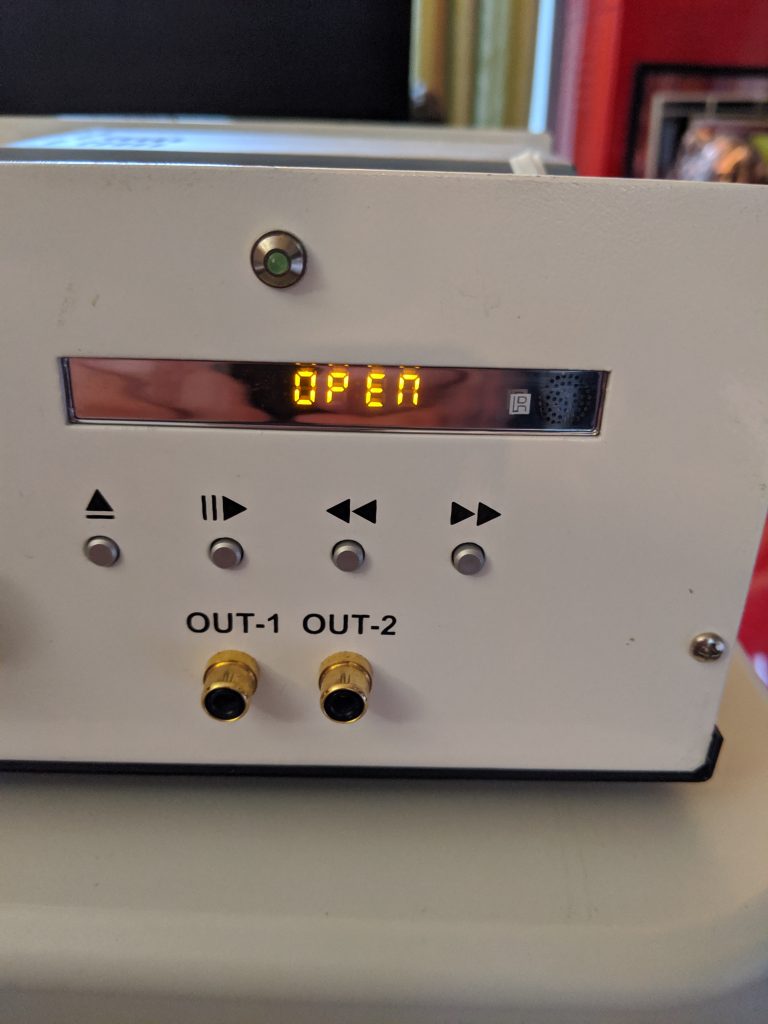
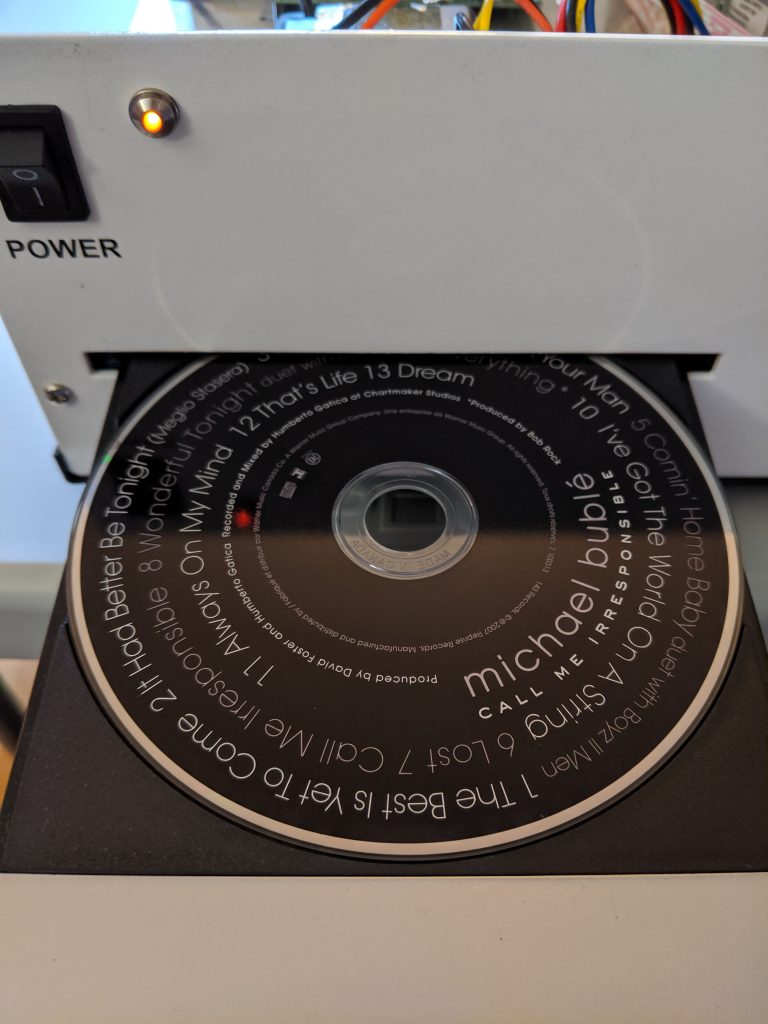
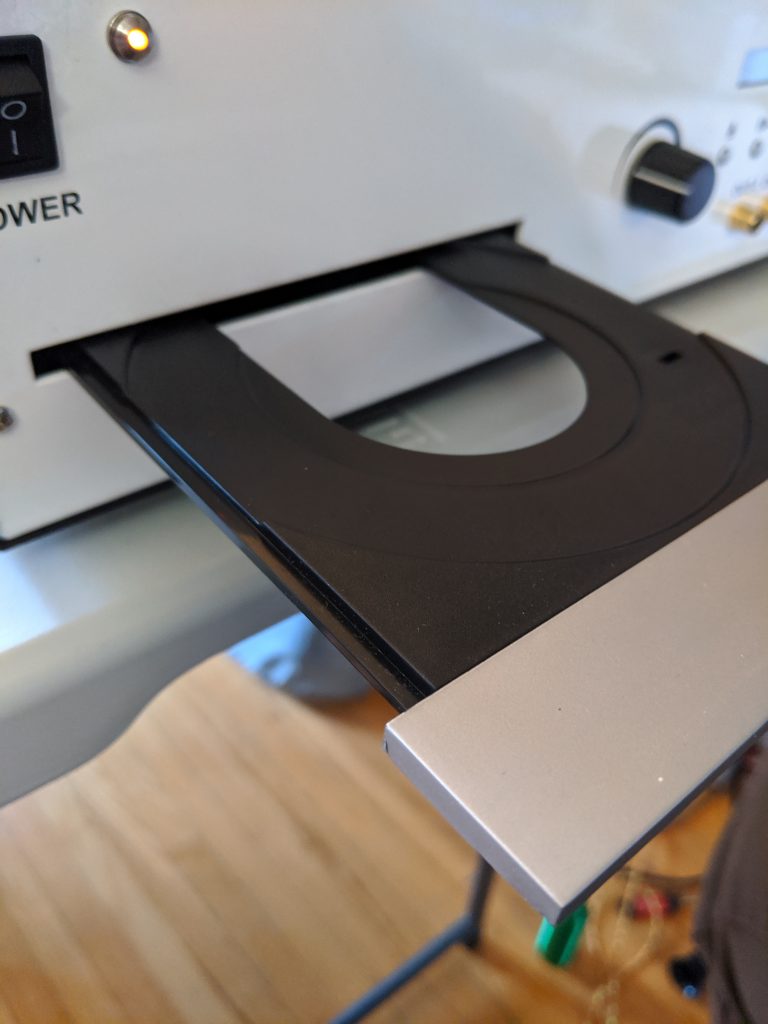
There really are no identifying marks on this. No idea how it got to be in Canada.
YouTube’s automatic transcription is not quite there yet:
… it’s got a different feel to it it’s um
Robyn Hitchcock, Trilobite, as transcribed by YouTube
I write this in a shower in Thunder Bay
I mean you know like a shower that you
clean yourself in not a shower of rain
or you could clean yourself in a shower
of rain but you don’t always know it’s
gonna rain and you’re not necessarily
dirty at precisely the right time to go
out into the rain but it would be great
if people could time their dirt so they
went out and obviously if you’ve got
small kids and you need to bathroom
regularly because they’re not old enough
to voluntarily shower or bathe you could
just wait for for the shower that would
doom for you none for the infants anyway
I wrote this in Thunder Bay and it’s
about a creature that’s been extinct now
for about 100 million years but it
lasted about 400 million years which is
a lot longer than we are likely to
nonetheless we in our brief lifespan
have already named this creature and
it’s it looks kind of like a ladies
shaving device from the 1940s but
obviously it made a stone because it’s
fossilized it’s called a trilobite
because it has three lobes three
sections to it and you can find a lot of
these still fossilized trilobite sand
cliffs in various parts of the world
they may even be on on the moon for
honor but it’s very hard to prove either
way but you know we’ve called it this
thing the trilobite but long after it’s
like as if somebody dug one of you up in
years to come and said these are the
bones of Gloria Swanson you know you
always who remember you sir particularly
and not Gloria Swanson um as far as I
know because you haven’t proved you on
but I’m assuming you are for all I know
all of you are actually called Gloria
Swanson which only proves my point the
chorus of the song refers to
refers to Elton John buying cheap
confectionery in a down market cafe in
the late 60s before he became famous and
wasn’t able to do that had to get
someone else to do it for him and it has
no connection with the rest of the song
so ok that’s set the scene for this
anyway
trilobite right Dwight’s in the light by
trilobite right in the light by Dwight
trilobite right Dwight’s in the light by
trilobite right in the light by Dwight
basking on the shores of time the little
Stein creature ain’t dead to the world
they call him trilobite right rights in
the light by trilobite right in the
light by Dwight trilobite right rights
in the light by trilobite brighten the
light by Dwight Weldon Johnson but real
name is Richard wood creaking away for a
second of Fame a billion years later
they give it a name they call a
trilobite right and whites in life by
trilobite right in the light by Dwight
when I’m too wasted these rocks to
clamber then lean me on the cliff and
encase me in amber and the creature from
the future in way out when can clop my
fossil and name me span that’s a nice
day
built for a world where nothing needs
shaving yoga then stone ants and I are
waving trilobite right and whites in the
light by trial of pipe right in the
light by Dwight let’s hold a clicking
championship the trilobite wins and
everybody else loses
trilobite try to buy
The chorus in real life is:
Trilobite, right Dwight’s in the Lite Bite
Trilobite, right in the Lite Bite, Dwight
PLOTPOURRI is an old BASIC graphics demo for the Apple II. It plots 3D functions immensely slowly. It was noticed on the stardot forum, and a BBC BASIC version was requested.


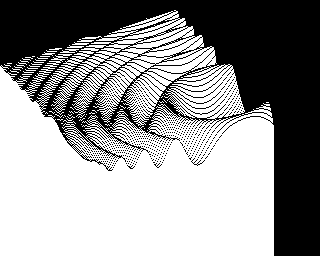

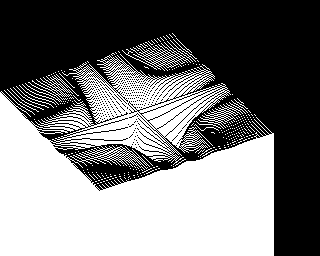
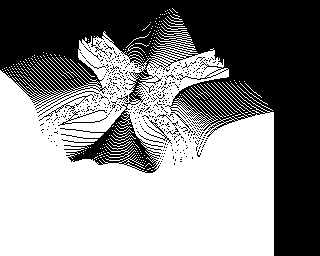
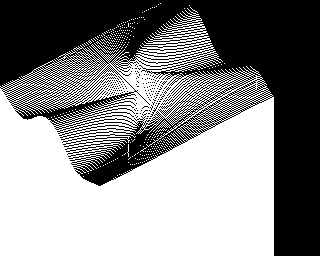



My conversion lives here: scruss/plotpourri_bbc.bas and runs in the browser here.
Printing from computers goes through waves of being difficult to being easy, then back to difficult again. This is likely due to the cycles of technology, complexity and user demand flow in and out of sync. I think we’re at peak annoyance right now.
It’s even harder with Raspberry Pis, as when printer drivers support Linux, 90% of them are for x86 or x86_64 computers only (Canon: ಠ_ಠ). ARM doesn’t get a look in. But one technology does actually seem to help: network printers that support IPP — Internet Printing Protocol.
We had an old Brother laser printer that just got slower and crankier and less useful as a printer, so yesterday I got a new Brother DCP-L2550DW to replace it. It says it supports Linux in the spec, but I knew not to be too optimistic with my Raspberry Pis. And indeed, it was seen on the network but no driver was found. I had a sad.
What turned my frown upside down was finding out about Raspbian’s cups-ipp-utils package. For desktop use, install it this way:
sudo apt install cups cups-ipp-utils system-config-printer
(leave off system-config-printer if you’re running from the terminal.)
Update: while you’re here, you might also want to install the print-to-PDF driver too. This allows you to print without wasting paper. Install it (and the IPP driver) with:
sudo apt install cups cups-ipp-utils system-config-printer printer-driver-cups-pdf
In many cases, this might be all you need to do: the network printers should be automatically found and added as devices.
On the desktop, open up Preferences → Print Settings and add a new printer. Yes, it prompts for your user password which you may have forgotten. I’ll wait while you try to remember it …
Now under Network Printers, you should see a device you recognize. Pick the one that says IPP network printer somewhere:

Here’s where the magic happens: you actually want to pick the generic driver for once:

And again, the IPP utilities package will have picked the right driver for you:
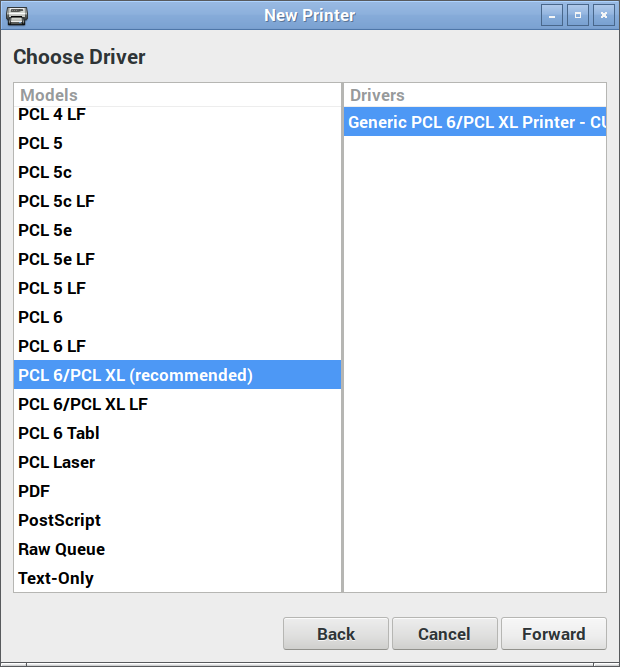
Changing the name and location is optional:

Hit Apply, and you should be printing!
(Hey, printer manufacturers have been known to be evil and make good, working stuff suddenly not work. IPP is supposed to make everything sparkly again, but I can’t guarantee that something wicked won’t come this way.)
Update: After a few months of using the Brother DCP-L2550DW, I don’t recommend you buy it. It’s a perfectly capable printer, but it takes ‘chipped’ toner cartridges that:
To get around (1), select Continue instead of Stop in the Toner Out configuration menu.
Update, January 2020: with sales and all needing a printer for work, the DCP-L2550DW will go with me to the office. I now have a MFC-L2750DW at home that scans to network, amongst other things. IPP proved it was magic yet again by the new printer being found and just worked with all my machines as soon as I added it to the network.
The greatest common divisor (gcd) of two natural numbers is the largest number that evenly divides both. For instance gcd(8, 12) is 4. There are many clever and efficient ways to calculate the gcd of two numbers on a Linux machine. The method presented here is not among them.
#!/bin/bash
gcd(){ comm -12 --nocheck-order <(factor $1|sed 's/^[^ ]*/1/;s/ /\n/g') <(factor $2|sed 's/^[^ ]*/1/;s/ /\n/g')|tr '\n' \*|sed 's/.$/\n/'|bc;}
gcd $1 $2
(Contrived) example:
gcd.sh 24691357802469135780246913578 61728394506172839450617283945
12345678901234567890123456789
Which breaks down as:
| prime factors of 24691357802469135780246913578 |
prime factors of 61728394506172839450617283945 |
| 2 | |
| 3 | 3 |
| 3 | 3 |
| 3 | 3 |
| 5 | |
| 7 | 7 |
| 13 | 13 |
| 31 | 31 |
| 37 | 37 |
| 211 | 211 |
| 241 | 241 |
| 2161 | 2161 |
| 3607 | 3607 |
| 3803 | 3803 |
| 2906161 | 2906161 |
Multiply the factors common to both:
3 × 3 × 3 × 7 × 13 × 31 × 37 × 211 × 241 × 2161 × 3607 × 3803 × 2906161 = 12345678901234567890123456789
I’m sure someone else has used the output of factor and comm in this way before. The hard part was getting coprime numbers to output 1.